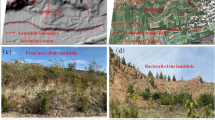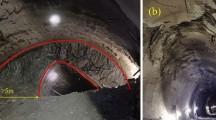Abstract
A fluid–solid coupled numerical simulation was carried out for the Zhaolou coal mine using Flac3D software. The results showed that: (1) when the failure depth of the floor exceeded the extension depth of the floor rock mass and the hydrostatic seepage pressure of the fractured structure surface exceeded the stress state of the fractured element, floor water inrush will occur. (2) With other factors being equal, if the footwall is mined first, the pore pressure concentration near the fault is more obvious, and the floor-confined water is lifted 10–25 m higher than when the hanging-wall is mined first. Mining the floor adversely affects its plastic zone, and the failure depth is ≈ 10 m greater than when the hanging wall is mined first. (3) When advancing against the fault dip, the pore pressure concentration near the fault is more obvious, and the floor confined water is lifted 5–20 m higher than when the mine advances along the fault dip. Again, mining the floor first disrupts the floor plastic zone, and the failure depth is approximately 5 m greater than when the mine is advanced along the fault dip. (4) The risk of floor-water inrush is minimized when the hanging-wall is mined first and the mine advances along the fault dip; the risk is greatest when the footwall is mined first and is advanced against the fault dip. These results provide a theoretical basis for preventing mine water inrush.
采矿对含断层煤层底板破坏的影响:赵楼矿(中国)数值模拟
利用Flac3D对赵楼矿进行固液耦合数据模拟。结果表明:(1) 当底板破坏深度超过底板岩体深度和裂隙构造表面静水渗透压力过大时,底板将发生突水;(2) 在保证其它条件相同时,若先开采断层下盘,断层附近孔隙水压集中明显,底板水位抬升高度比先开采断层上盘高10~25m,底板塑性区发育受负面影响而使底板破坏深度比先开采断层上盘深10m。(3) 如果迎断层倾斜方向回采,断层附近孔隙水压力集中明显,底板水位抬升高度比顺断层倾斜方向回采深5~20 m,破坏底板塑性区并使底板破坏深度比顺断层倾斜方向开采深5m。(4) 先开采断层上盘和顺断层倾斜方向回采将降低底板突水危险,反之增大突水风险。研究为底板突水预防提供了理论基础。
Zusammenfassung
Mittels Flac3D wurde eine numerische gekoppelte Fluid-Feststoff Modellierung für die Zhaolou-Kohlemine durchgeführt. Die Ergebnisse zeigten, dass (1) ein Eindringen des Bodenwassers auftritt, wenn die Bruchtiefe der Oberfläche die Mächtigkeit des Liegenden übersteigt und der hydrostatische Sickerwasserdruck größer als der Spannungszustand des Bruchelementes ist. (2) Die Störung deutlicher ist und das gespannte Wasser 10 bis 25 m höher steigt, wenn die Sohle zuerst abgebaut wird im Vergleich zum Abbau an der Firste. Die Tiefe der Störung ist bei Abbaubeginn an der Sohle etwa 10 m größer als beim Abbaubeginn an der Firste. (3) Die Störung deutlicher ist und das gespannte Wasser 5 bis 20 m höher steigt, wenn der Vortrieb entgegen dem Störungseinfallen erfolgt als entlang dem Einfallen der Störung. Analog zu (2) ist die Bruchtiefe etwa 5 m größer als beim Vortrieb entlang dem Störungseinfallen. (4) Das Risiko des Eindringens von Wasser minimiert wird, wenn der Abbau an der Firste beginnt und der Vortrieb entlang dem Störungseinfallen erfolgt. Das Risiko ist am größten, wenn zuerst die Sohle abgebaut wird und der Vortrieb entgegen dem Einfallen erfolgt. Diese Ergebnisse liefern eine theoretische Grundlage zur Verhinderung eines Grubenwassereinbruchs.
Resumen
Se llevó a cabo una simulación numérica acoplada fluida-sólida para la mina de carbón Zhaolou utilizando el software Flac3D. Los resultados mostraron que: (1) Cuando la profundidad de falla del piso excedió la profundidad de extensión de la masa rocosa del piso y la presión de filtración hidrostática de la superficie de la estructura fracturada excedió el estado de tensión del elemento fracturado, se producirá la entrada de agua del piso. (2) Con otros factores iguales, si se realiza el trabajo minero sobre el muro inferior, la concentración de presión de poro cerca de la falla es más obvia y el agua confinada en el suelo se levanta 10 ~ 25 m por encima de cuando se trabaja primero la pared superior. La explotación minera del suelo afecta negativamente su zona plástica y la profundidad de falla es ≈10 m mayor que cuando se explota primero la pared superior. (3) Al avanzar contra la falla, la concentración de presión de poro cerca de la falla es más obvia y el suelo confinado se levanta 5 ~ 20 m por encima de la que se obtiene cuando se avanza a favor de la pendiente de la falla. Nuevamente, si inicialmente se trabaja primero el piso, se interrumpe la zona plástica del piso y la profundidad de la falla es aproximadamente 5 m mayor que cuando la minería avanza a lo largo de la pendiente de falla. (4) El riesgo de irrupción de agua a través del piso se minimiza cuando la pared opuesta se trabaja primero y la minería avanza a lo largo de la pendiente de falla; el riesgo es mayor cuando la pared del piso se trabaja primero y la minería avanza en contra de la pendiente de la falla. Estos resultados proporcionan una base teórica para evitar la irrupción de agua en las minas.








Similar content being viewed by others
References
Chen PS, Gu JC, Li WX (1977) Research on earthquake rupture process and earthquake prediction from the point of view of fracture mechanics. Chin J Geophys 20(3):185–202
Jia SP, Chen WZ, Yu HD, Li XL (2009) Research on seepage-stress coupling damage model of boom clay during tunneling. Rock Soil Mech 30(1):19–26
Jiang JQ, Wu QL, Qu H (2015) Characteristic of mining stress evolution and activation of the reverse fault below the hard-thick strata. Coal Sci Technol 40(2):267–277
Lamoreaux JW, Wu Q, Zhou W (2014) New development in theory and practice in mine water control in china. Carbonate Evaporite 29(2):141–145
Li ZH, Zhai CZ, Li FL (2005) Experimental study on water inrush mechanism due to floor faults activation in mining above confined aquifer. J Cent Univ 46(5):1806–1811
Liu WT, Mu DR, Xie XX (2017) Sensitivity analysis of the main factors controlling floor failure depth and a risk evaluation of floor water inrush for an inclined coal seam. Mine Water Environ. https://doi.org/10.1007/s10230-017-0497-6
Lu X, Liu Q, Wu C, Zhao J (2009) Hydro-mechnaical coupling analysis of mining effect around fault fractured zone. Rock Soil Mech 30(S1):165–168
Miao X, Liu W, Chen Z (2004) Seepage Theory of Mining Rock Mass. Science Press, Beijing
Rutqvist J, Stephansson O (2003) The role of hydromechanical coupling in fractured rock engineering. Hydrogeol J 11(1):7–40
Shen JJ (2014) Research on fracture expanding in deep mine and water inrush channel formation mechanism. Shandong Univ of Science and Technology, Qingdao
Wang HF (2000) Theory of linear poroelasticity. Princeton
Wang ZY, Liu HQ (1992) Mining Above Pressure Water. China Coal Industry Publ House, Beijing
Wu J (2007) Coal seam floor effect and rock mass structure of water resistance performance control action research. China Univ of Mining, Xuzhou
Wu Q, Liu YZ, Liu DH, Zhou WF (2011) Prediction of floor water inrush: the application of GIS-Based AHP vulnerable index method to Donghuantuo coalmine, China. Rock Mech Rock Eng 44(5):591–600
Xu ZL (2007) Elastic Mechanics. Higher Education Press, Beijing
Xu JP, Zhang FC, Gui H, Zhang TJ (2012) Characteristics and experimental study of water conduction caused by fault activation due to mining. J China Univ Min Technol 41(3):415–419
Yuan ZG, Wang HT, Hu GZ, Fan XG, Liu NP (2012) Numerical simulation of hydraulic fracturing of crossing borehole and its engineering application. J Chin Coal Soc 37(S1):109–114
Zhang Y, Pang YH (2010) Water-inrush mechanical model based on a theory of coupled stress-seepage. J Chin U Min Tech 39(5):659–664
Zhang J, Zhang Y, Liu T (1997) Rock Mass Permeability and Water Inrush of Coal Mines. Geological Publ House, Beijing
Acknowledgements
This work was financially supported by the National Natural Science Foundation of China (Grant 51274135) and the graduate student science and technology innovation project of Shandong University of Science and Technology (SDKDYC180101).
Author information
Authors and Affiliations
Corresponding authors
Rights and permissions
About this article
Cite this article
Meng, X., Liu, W. & Mu, D. Influence Analysis of Mining’s Effect on Failure Characteristics of a Coal Seam Floor with Faults: A Numerical Simulation Case Study in the Zhaolou Coal Mine. Mine Water Environ 37, 754–762 (2018). https://doi.org/10.1007/s10230-018-0532-2
Received:
Accepted:
Published:
Issue Date:
DOI: https://doi.org/10.1007/s10230-018-0532-2




